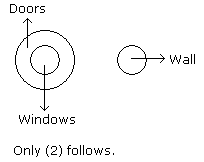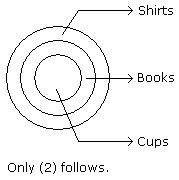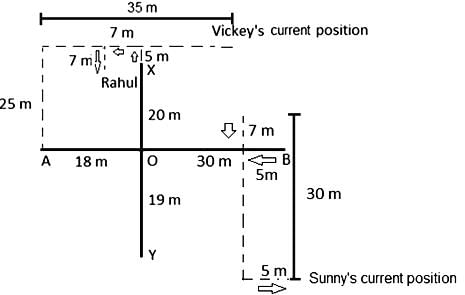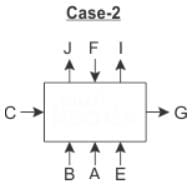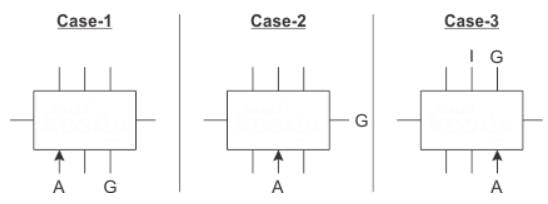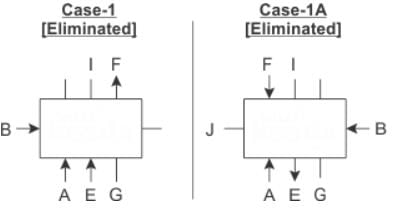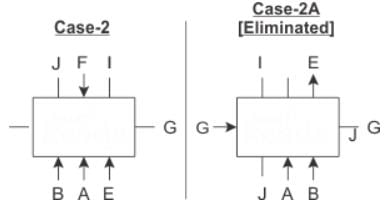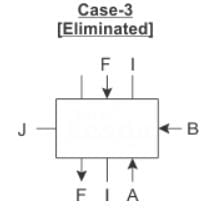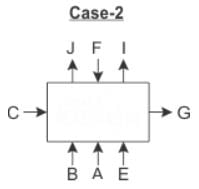SSC GD Constable Mock Test - 6 - SSC MTS / SSC GD MCQ
30 Questions MCQ Test - SSC GD Constable Mock Test - 6
Directions to Solve
In each of the following questions two statements are given and these statements are followed by two conclusions numbered (1) and (2). You have to take the given two statements to be true even if they seem to be at variance from commonly known facts. Read the conclusions and then decide which of the given conclusions logically follows from the two given statements, disregarding commonly known facts.
Question -
Statements: All the windows are doors. No door is a wall.
Conclusions:
- Some windows are walls.
- No wall is a door.
Directions to Solve
In each of the following questions two statements are given and these statements are followed by two conclusions numbered (1) and (2). You have to take the given two statements to be true even if they seem to be at variance from commonly known facts. Read the conclusions and then decide which of the given conclusions logically follows from the two given statements, disregarding commonly known facts.
Question -
Statements: All cups are books. All books are shirts.
Conclusions:
- Some cups are not shirts.
- Some shirts are cups.
Directions: Study the following information and answer the question given below it.
There is an XY axis in such a way that X is in north and Y is in south direction. There is an AB axis in such a way that A is in west direction and B is in east direction. AB axis and XY axis intersect at a point O in such a way that XO is 20 m, OY is 19 m, OA is 18 m and OB is 30 m. Sunny starts from point B and walks 5 m towards west, then turns to his right and walks 7 m, then walks 30 m in south direction, and finally turns to his left and walks 5 m. Vickey starts from point A and walks 25 m in north direction, and then turns right and walks 35 m in east direction. Rahul starts from point X and walks 5 m in north direction, then turns to his left and walks 7 m, and again turns to his left and walks 7 m.
Q. Point X is in which direction with respect to Vickey's current position?
Direction : Study the following question carefully and choose the right answer.
Q: In a particular way the word STAG is coded as HGZT, HORN as SLIM. Using the same coding, how can NORTH be written?
Directions: Read the following information carefully and answer the questions given beside.
Eight persons viz. A, B, C, E, F, G, I and J sit around a rectangular table such that three persons sit on each longer side and one person sits on each shorter side. Nobody sits at the corners. The persons whose name starts with vowel do not sit on the shorter side of the table. Three of them face away from centre while the rest five face towards the centre.
B, who faces centre sits second to the left of E. J is on the immediate right of F, who is at a gap of two persons from E. Neither C nor A face away from centre. The immediate neighbors of F face away from centre. G is second to the right of A. I is on the immediate left of F. I is neither adjacent to A nor to C. E is adjacent to G.
Q. Who among the following faces away from centre?
I. J
II. F
III. I
At what percentage per annum, will Rs. 10,000 amount to 17,280 in three years? (Compound Interest being reckoned)
In a fort there was sufficient food for 200 soldiers for 31 days. After 27 days 120 soldiers left the fort. For how many extra days will the rest of the food last for the remaining soldiers?
Weights of two friends A and B are in the ratio of 1:2. A’s weight increases by 20% and the total weight of A and B together becomes 60 kg, with an increase of 30%. By what percent the weight of B increase?
The marked price of an article is 20% higher than the cost price. A discount of 20% is given on the marked price. In this transaction the seller
Umesh purchased 360 eggs at the rate of 78 paise each. On this, he paid Rs. 14 as octroi, Rs. 13 as transport and Rs. 5 as additional charges. He kept 7 eggs for himself. At what rate should he sell each of the remaining eggs to get a total profit of Rs. 70?
A sold a watch to B at a gain of 5% and B sold it to C at a gain of 4%. If C paid Rs. 1,092 for it, the price paid by A is
If 350 stones of spherical shape are dropped into a hemispherical cup containing some water, they get fully submerged. Diameter of the cup is 14 m. What will be the radius of the stone, if the water just spills off from the hemispherical cup?
The Lahore Session of the Indian National Congress (1929) is very important in history because
- The Congress passed a resolution demanding complete independence.
- The rift between the extremists and moderates was resolved in that session.
- A resolution was passed rejecting the two-nation theory in that session.
Which of the statements given above is/are correct?
How many runs did Sachin Tendulkar was scored in his ODI debut?
Cathode rays when obstructed by metal cause emission of -
The mountain range which divides the North and the South India is–
Which authority recommends the principles gov erring the grantsin-aid of the revenues of the States out of the Consolidated Fund of India?
What is the primary objective of World Paper Bag Day?
In the following questions four alternatives are given for the idiom/phrase italicised and underlined in the sentence. Choose the alternative which best expresses the meaning of idiom/phrase.
Q. The project did not appear to hold out bright prospects.
Direction: In each of the questions given below, a sentence is given with two blanks. From the given options, choose the one that gives the correct combination of words that fit in the blanks.
Delivery partners are ____________ made to understand the practical ____________ of the job as they choose to enter the workforce.
Direction: In each of the questions given below, a sentence is given with two blanks. From the given options, choose the one that gives the correct combination of words that fit in the blanks.
This would be _______________ by a weak phase of the monsoon when rains get _______________ to the foothills of the Himalayas.
Direction: The sentences given in the question, when properly sequenced, form a coherent paragraph. Each sentence is labeled with a letter. Choose the most logical order of sentences from the given choices to construct a coherent paragraph.
A. The quest to define units of measurement using constants of nature goes back to the creation of the metric system during the French Revolution.
B. It was a utopian project, with its creators imagining that a shared system of weights and measures would unite the world, allowing for the free exchange of goods and information.
C. The metric system was created with the intention of liberating the common man and woman from the confusing and inconsistent weights and measures of the old regime.
D. At this time, the ideology of liberty, equality, fraternity was embraced not just by revolutionaries, but by scientists as well.
Direction: Read the following passage carefully and answer the following questions.
The Bureau of Indian Standards (BIS) has kicked off the process to set new standards to measure quality of services offered to consumers across different sectors, including telecom, aviation, e-commerce and healthcare.
The BIS, which sets the quality regulations for various products from gold to bottled water, on Friday called a meeting of industry bodies to “persuade them to be part of the process and give their inputs.”
“Service sector is one of the key sectors of the Indian economy with a huge potential to grow into one of the largest markets of the world. Standards can play a major facilitative role in this regard. It is important that the standardisation needs and priorities of the sector are determined,” a senior official said.
During the meeting, the BIS pointed out that the initial focus will be the 12 champion services sectors identified by the government. These include IT, tourism and hospitality, transport and logistics, accounting and finance services, legal services, communication services and construction.
The Bureau of Indian Standards (BIS) standards is set to formulate a framework for quality services that should be provided to consumers and also talk about the benchmarks to deal with consumer complaints or after sales service in an effort to ensure quality in the services sector.
At a meeting with industry bodies on Friday, it has been decided that the BIS will set up a separate ‘divisional council’ for services in a month’s time. Under this, different technical committees will be set up — one for each service. The committees will have various stakeholders such as government officials, experts and industry representatives.
The process was initiated after concerns over lack of standardisation, particularly with regards to after-sales service, in their feedback to the Ministry of Consumer Affairs.
In a poll, online community network LocalCircles found that in the absence of defined customer service standards in the country, a majority of consumers were not happy with after-sales services. As per the poll, 43% feel that mobile handset and computer manufacturers are the worst in after-sales services, followed by white goods firms (38%) and automobile companies (11%). About 93% of respondents said brands should at least acknowledge complaints from users within 72 hours. “Many consumers complained that customer service numbers of many companies do not work,” according to LocalCircles.
Q. Which among the following is true regarding the poll conducted by the community network LocalCircles regarding customer service in India?
I. The mobile phone manufacturers are mostly interested in selling the products without giving much attention to the after sales service
II. Many sectors in India are facing the issue of after sales service in the country and nothing is being done to take care of this issue
III. It is important that the complaints of the customers should be acknowledged first by the service providers
Direction: Read the following passage carefully and answer the following questions.
The Bureau of Indian Standards (BIS) has kicked off the process to set new standards to measure quality of services offered to consumers across different sectors, including telecom, aviation, e-commerce and healthcare.
The BIS, which sets the quality regulations for various products from gold to bottled water, on Friday called a meeting of industry bodies to “persuade them to be part of the process and give their inputs.”
“Service sector is one of the key sectors of the Indian economy with a huge potential to grow into one of the largest markets of the world. Standards can play a major facilitative role in this regard. It is important that the standardisation needs and priorities of the sector are determined,” a senior official said.
During the meeting, the BIS pointed out that the initial focus will be the 12 champion services sectors identified by the government. These include IT, tourism and hospitality, transport and logistics, accounting and finance services, legal services, communication services and construction.
The Bureau of Indian Standards (BIS) standards is set to formulate a framework for quality services that should be provided to consumers and also talk about the benchmarks to deal with consumer complaints or after sales service in an effort to ensure quality in the services sector.
At a meeting with industry bodies on Friday, it has been decided that the BIS will set up a separate ‘divisional council’ for services in a month’s time. Under this, different technical committees will be set up — one for each service. The committees will have various stakeholders such as government officials, experts and industry representatives.
The process was initiated after concerns over lack of standardisation, particularly with regards to after-sales service, in their feedback to the Ministry of Consumer Affairs.
In a poll, online community network LocalCircles found that in the absence of defined customer service standards in the country, a majority of consumers were not happy with after-sales services. As per the poll, 43% feel that mobile handset and computer manufacturers are the worst in after-sales services, followed by white goods firms (38%) and automobile companies (11%). About 93% of respondents said brands should at least acknowledge complaints from users within 72 hours. “Many consumers complained that customer service numbers of many companies do not work,” according to LocalCircles.
Q. Which among the following is true regarding the standardization drive to be initiated by the Bureau of Indian Standards?
I. It will focus on the services sector and all the services will be focused under this new initiative
II. The main reason for initiating this drive is the servicing post sales of any product
III. This standardization will focus on framing a benchmark for the quality of service in the country
Direction: Read the following passage carefully and answer the following questions.
The Bureau of Indian Standards (BIS) has kicked off the process to set new standards to measure quality of services offered to consumers across different sectors, including telecom, aviation, e-commerce and healthcare.
The BIS, which sets the quality regulations for various products from gold to bottled water, on Friday called a meeting of industry bodies to “persuade them to be part of the process and give their inputs.”
“Service sector is one of the key sectors of the Indian economy with a huge potential to grow into one of the largest markets of the world. Standards can play a major facilitative role in this regard. It is important that the standardisation needs and priorities of the sector are determined,” a senior official said.
During the meeting, the BIS pointed out that the initial focus will be the 12 champion services sectors identified by the government. These include IT, tourism and hospitality, transport and logistics, accounting and finance services, legal services, communication services and construction.
The Bureau of Indian Standards (BIS) standards is set to formulate a framework for quality services that should be provided to consumers and also talk about the benchmarks to deal with consumer complaints or after sales service in an effort to ensure quality in the services sector.
At a meeting with industry bodies on Friday, it has been decided that the BIS will set up a separate ‘divisional council’ for services in a month’s time. Under this, different technical committees will be set up — one for each service. The committees will have various stakeholders such as government officials, experts and industry representatives.
The process was initiated after concerns over lack of standardisation, particularly with regards to after-sales service, in their feedback to the Ministry of Consumer Affairs.
In a poll, online community network LocalCircles found that in the absence of defined customer service standards in the country, a majority of consumers were not happy with after-sales services. As per the poll, 43% feel that mobile handset and computer manufacturers are the worst in after-sales services, followed by white goods firms (38%) and automobile companies (11%). About 93% of respondents said brands should at least acknowledge complaints from users within 72 hours. “Many consumers complained that customer service numbers of many companies do not work,” according to LocalCircles.
Q. Which among the following will be framework for standardization initiative of the Bureau of Indian Standards with regard to the services sector?
Direction: Read the following passage carefully and answer the following questions.
The Bureau of Indian Standards (BIS) has kicked off the process to set new standards to measure quality of services offered to consumers across different sectors, including telecom, aviation, e-commerce and healthcare.
The BIS, which sets the quality regulations for various products from gold to bottled water, on Friday called a meeting of industry bodies to “persuade them to be part of the process and give their inputs.”
“Service sector is one of the key sectors of the Indian economy with a huge potential to grow into one of the largest markets of the world. Standards can play a major facilitative role in this regard. It is important that the standardisation needs and priorities of the sector are determined,” a senior official said.
During the meeting, the BIS pointed out that the initial focus will be the 12 champion services sectors identified by the government. These include IT, tourism and hospitality, transport and logistics, accounting and finance services, legal services, communication services and construction.
The Bureau of Indian Standards (BIS) standards is set to formulate a framework for quality services that should be provided to consumers and also talk about the benchmarks to deal with consumer complaints or after sales service in an effort to ensure quality in the services sector.
At a meeting with industry bodies on Friday, it has been decided that the BIS will set up a separate ‘divisional council’ for services in a month’s time. Under this, different technical committees will be set up — one for each service. The committees will have various stakeholders such as government officials, experts and industry representatives.
The process was initiated after concerns over lack of standardisation, particularly with regards to after-sales service, in their feedback to the Ministry of Consumer Affairs.
In a poll, online community network LocalCircles found that in the absence of defined customer service standards in the country, a majority of consumers were not happy with after-sales services. As per the poll, 43% feel that mobile handset and computer manufacturers are the worst in after-sales services, followed by white goods firms (38%) and automobile companies (11%). About 93% of respondents said brands should at least acknowledge complaints from users within 72 hours. “Many consumers complained that customer service numbers of many companies do not work,” according to LocalCircles.
Q. Which among the following is the main reason of initiating the standardization drive of the Bureau of Indian Standards for the services sector?


